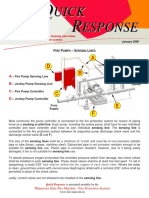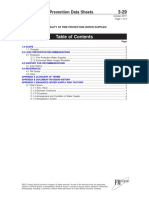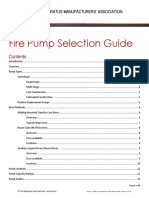FMDS0404N
Uploaded by
Story LoveCopyright:
Available Formats
FMDS0404N
Uploaded by
Story LoveCopyright
Available Formats
Share this document
Did you find this document useful?
Is this content inappropriate?
Copyright:
Available Formats
FMDS0404N
Uploaded by
Story LoveCopyright:
Available Formats
FM Global
Property Loss Prevention Data Sheets
4-4N
January 2001
Supersedes September 1998
Page 1 of 5
STANDPIPE AND HOSE SYSTEMS
Table of Contents
Page
1.0 SCOPE ................................................................................................................................................... 2
1.1 Changes ............................................................................................................................................ 2
1.2 Superseded Information ................................................................................................................... 2
2.0 FM GLOBAL INTERPRETATION .......................................................................................................... 2
2.1 Introduction ...................................................................................................................................... 2
2.1.1 Shall versus Should .............................................................................................................. 2
2.1.2 Authority Having Jurisdiction ................................................................................................. 2
2.1.3 Listed or Approved ................................................................................................................ 2
2.1.4 Related NFPA Standards ...................................................................................................... 2
2.2 Protection ......................................................................................................................................... 2
2.3 Operation And Maintenance ............................................................................................................ 4
2.3.1 Tests and Inspection ............................................................................................................. 4
3.0 SUPPORT FOR RECOMMENDATIONS ............................................................................................... 4
4.0 REFERENCES ....................................................................................................................................... 5
4.1 FM Global ........................................................................................................................................ 5
4.2 NFPA Standards .............................................................................................................................. 5
APPENDIX A DOCUMENT REVISION HISTORY ....................................................................................... 5
List of Figures
Fig. FM1. Two zone system. ........................................................................................................................... 3
2000 Factory Mutual Insurance Company. All rights reserved. No part of this document may be reproduced,
stored in a retrieval system, or transmitted, in whole or in part, in any form or by any means, electronic, mechanical,
photocopying, recording, or otherwise, without written permission of Factory Mutual Insurance Company.
4-4N
Standpipe and Hose Systems
Page 2
FM Global Property Loss Prevention Data Sheets
1.0 SCOPE
FM Global has accepted and adopted NFPA Standard 14, Standard for the Installation of Standpipe, Private
Hydrant and Hose Systems, 2000 Edition.
This data sheet addresses design and installation of Standpipe and Hose Systems as it pertains to the
conservation and protection of property.
1.1 Changes
This document establishes Data Sheet 4-4N as a new and independent document to NFPA 14.
1.2 Superseded Information
This new standard supersedes all previous information in Data Sheet 4-4N.
2.0 FM GLOBAL INTERPRETATION
2.1 Introduction
Design and install standpipe and hose system in accordance with NFPA 14, Standard for the Installation of
Standpipe, Private Hydrant and Hose Systems, 2000 Edition. In its application, use the following
interpretations.
2.1.1 Shall versus Should
In most if not all instances, the widespread use in the text of NFPA 14, the mandatory shall can be replaced
by the more permissive should. This is in keeping with other FM Global Standards.
2.1.2 Authority Having Jurisdiction
There are many references in the text of NFPA 14 to the authority having jurisdiction. Legally this could mean
the state fire marshal, local fire department, or some other state or municipal office. In the application of
this standard the reference is solely to FM Global unless the legal authority takes precedence.
2.1.3 Listed or Approved
Within the NFPA Standard, Listed means equipment approved by Factory Mutual Research and listed in
the Factory Mutual Research Approval Guide.
Within the NFPA Standard, Approved means acceptance to the Factory Mutual Insurance Company. Factory
Mutual Research Approved equipment should be used whenever possible.
2.1.4 Related NFPA Standards
There are a number of references in NFPA 14 to other NFPA standards. In most instances FM Global has
its own corresponding standard. FM Global standards will generally take precedence.
2.2 Protection
2.2.1 Treat Appendix A material in NFPA 14 as recommended practice applicable to FM Global insured
locations. (Paragraph 1-1 and Appendix A material)
2.2.2 Provide standpipes in the stair towers of buildings five or more stories high, and in windowless buildings, four or more stories high. In windowless buildings, provide standpipes just inside doors to fire escapes.
(Paragraph 5-3)
2.2.3 Combined Systems. Apply Data Sheet 2-8N to the automatic sprinkler portions of combined standpipe systems. (Paragraph 5-9.1.3)
2.2.4 Plans and Specifications. Submit plans and specifications for standpipes and hose systems to
FM Global. (Paragraph 6-1)
2.2.5 Use only automatic standpipe systems. (Paragraph 3-2)
2000 Factory Mutual Insurance Company. All rights reserved.
Standpipe and Hose Systems
FM Global Property Loss Prevention Data Sheets
4-4N
Page 3
2.2.6 Pump Arrangement. Design and install fire and booster pumps in accordance with Data Sheet 3-7N,
Stationary Pumps for Fire Protection (NFPA). (Paragraph 7-1.2)
2.2.7 Do not accept series staging of fire or booster pumps to supply water for sprinkler or standpipe systems
as indicated in paragraph 7-4 of NFPA 14 or shown in Figures A-5-1(b) and A-5-1(c) of NFPA 14. Install and
arrange fire and booster pumps in accordance with Data Sheet 3-7N. (Paragraph 7-4)
2.2.8 Arrange for automatic starting and manual stopping when fire or booster pump units supply water for
standpipes (see Data Sheet 3-7N). (Paragraph 7-1.1 and 7-1.2)
2.2.9 Figure 1 illustrates a two zone system for a building having a maximum height of 550 ft (168 m). It
differs from NFPA 14 Figure A-5-1(b) in that both fire pumps take their suction directly from the water supply.
If two water supplies are necessary, each zone should have the second pump in parallel or a gravity tank
at the top. The gravity tank may be refilled by the fire pump for that zone or by a separate tank-filling pump.
(Paragraph 5-1 and Fig. A-5-1(b))
Fig. FM1. Two zone system.
2.2.10 Where gravity or water tanks are needed, design and install tanks in accordance with FM Global Data
Sheet 3-2, Water Tanks for Fire Protection. (Paragraph 7-1.2)
2.2.11 Avoid the use of Standpipe zones exceeding 275 ft. For Buildings having three or more zones of
275 feet (84 m) each should duplicate the high zone arrangement from Figure 1 for the third and higher zones.
(Paragraph 5-2)
2.2.12 Make small (hand) hose connections to sprinkler pipes preferably to sprinkler systems serving areas
other than those in which the hose would be used. Otherwise, if the sprinkler system is shut off, the hand
hose would be without water (see Data Sheet 2-8N). (Paragraph 5-3.3 [see also NFPA 13 paragraph
5-15.5.1.1])
2.2.13 Location of Standpipes in Unheated Areas.
Small hose protection is needed for storage areas. Many such areas are unheated, so that piping is subject
to freezing in the winter. Under such conditions, the best practice is to locate the hose connection in an
adjacent heated area such as an office, washroom, or dry pipe valve enclosure. If there are no heated areas
in the immediate vicinity, the best arrangement is an approved remote control hose valve station.
2000 Factory Mutual Insurance Company. All rights reserved.
4-4N
Standpipe and Hose Systems
Page 4
FM Global Property Loss Prevention Data Sheets
Another acceptable method is a small approved deluge valve actuated by push buttons at each hose station.
An emergency power supply should be provided for any deluge valve electrical circuitry. Drains are needed
at low points. If pressure is not maintained on piping, ordinary hose valves may be used.
A less effective method is hose stations in unheated areas supplied by a small dry pipe valve separate from
the dry pipe valves supplying sprinklers. Low points should have dual valves and drum drips. Hose control
valves should have an automatic air maintenance device. Employees should be given special instruction in the
use of these hose stations, in that they should expect air to discharge for several seconds until water reaches
the hose. A pressure surge may be expected when water starts to flow.
Existing hose stations supplied on a shut-in-winter system are acceptable providing the control valve in the
heated area is on the same floor. The valve should be no more than 150 ft (45.7 m) from the hose connection, well marked, and readily accessible. Employees should be thoroughly instructed and drilled in emergency
operating procedures. New indoor hose connections should not use this method because of complications
regarding valve arrangements and the continuing need for employee education. (Paragraph 4-1-2.3)
2.2.14 Standpipe Installations In Buildings Under Construction. Provide at least one hose valve at each floor
with a connection for attaching fire department hose and an additional 1-12 inch outlet and hose for use by
personnel on the site until the fire department arrives. (Paragraph 10-1)
2.3 Operation And Maintenance
2.3.1 Tests and Inspection
For new underground piping the amount of leakage at the joints is limited to a maximum of two quarts per
hour (1.9 l/h) per 100 gaskets or joints irrespective of pipe diameter. The amount of allowable leakage may
be increased by one fluid ounce per inch valve diameter per hour (30 ml/25 mm/h) for each metal seated
valve isolating the test section. If dry barrel hydrants are tested with the main valve open, so the hydrants are
under pressure, an additional five ounces per minute (150 ml/min) leakage is permitted for each hydrant.
(Paragraph 9-4)
3.0 SUPPORT FOR RECOMMENDATIONS
Standpipes are used to supply water to hose outlets located throughout a building. Standpipes can be standalone systems, where only hose outlets are supplied or combination systems, where the standpipe system
also serves to supply water to sprinkler systems. Combined standpipe systems are very common in highrise buildings.
The use of standpipe systems is required by fire codes in the United States and the basic document for the
design and installation of systems is NFPA 14.
FM Global is an active participant in the development of NFPA 14. Over the years, FM Globals position has
paralleled NFPA 14 in most areas, except where noted in this standard. Major differences between NFPA
and FM Global position include:
1. FM Global does not recommend the arrangement of pumps in series to supply standpipe zones. Arranging the pump in series reduces the reliability of the system since failure of one single pump may result in
the loss of supply to the entire building.
2. FM Global does not recommend the use of standpipe zones exceeding 273 ft in height. Since standpipe
systems are designed to achieve a minimum hose outlet pressure at the top most hose outlet, an increase
in zone height translates into an increase in supply pressure at the base of the riser and the need for pressure
reducing valves (PRVs) for hose outlets and sprinkler systems located in the lower portions of the zones. The
PRVs are needed to prevent excessive pressures to hose outlets and sprinkler systems. PRVs are complex
in design, setting, maintenance, testing and operation and their use makes the overall system more complex.
2000 Factory Mutual Insurance Company. All rights reserved.
Standpipe and Hose Systems
FM Global Property Loss Prevention Data Sheets
4-4N
Page 5
4.0 REFERENCES
4.1 FM Global
Data Sheet 2-8N, Installation Of Sprinkler Systems (NFPA).
Data Sheet 2-8, Earthquake Protection for Water-Based Fire Protection Systems.
Data Sheet 3-2, Water Tanks for Fire Protection.
Data Sheet 3-7N/13-4N, Stationary Pumps for Fire Protection (NFPA).
4.2 NFPA Standards
NFPA 14, Standard for the Installation of Standpipe, Private Hydrant, and Hose Systems, 2000 Edition.
APPENDIX A DOCUMENT REVISION HISTORY
Data Sheet 4-4N was created in 1978. It included the exact text of NFPA 14, 1978 edition, including appendix
material, and the applicable FM Global comments in bold letters.
The 1978 version of Data Sheet 4-4N was revised in 1981 and restructured in 1998.
2000 Factory Mutual Insurance Company. All rights reserved.
You might also like
- The Subtle Art of Not Giving a F*ck: A Counterintuitive Approach to Living a Good LifeFrom EverandThe Subtle Art of Not Giving a F*ck: A Counterintuitive Approach to Living a Good Life4/5 (6055)
- The Gifts of Imperfection: Let Go of Who You Think You're Supposed to Be and Embrace Who You AreFrom EverandThe Gifts of Imperfection: Let Go of Who You Think You're Supposed to Be and Embrace Who You Are4/5 (1142)
- Never Split the Difference: Negotiating As If Your Life Depended On ItFrom EverandNever Split the Difference: Negotiating As If Your Life Depended On It4.5/5 (917)
- Hidden Figures: The American Dream and the Untold Story of the Black Women Mathematicians Who Helped Win the Space RaceFrom EverandHidden Figures: The American Dream and the Untold Story of the Black Women Mathematicians Who Helped Win the Space Race4/5 (946)
- The Hard Thing About Hard Things: Building a Business When There Are No Easy AnswersFrom EverandThe Hard Thing About Hard Things: Building a Business When There Are No Easy Answers4.5/5 (361)
- Devil in the Grove: Thurgood Marshall, the Groveland Boys, and the Dawn of a New AmericaFrom EverandDevil in the Grove: Thurgood Marshall, the Groveland Boys, and the Dawn of a New America4.5/5 (273)
- The World Is Flat 3.0: A Brief History of the Twenty-first CenturyFrom EverandThe World Is Flat 3.0: A Brief History of the Twenty-first Century3.5/5 (2283)
- A Heartbreaking Work Of Staggering Genius: A Memoir Based on a True StoryFrom EverandA Heartbreaking Work Of Staggering Genius: A Memoir Based on a True Story3.5/5 (233)
- BR PL Full Price List 2013 en Us 46471 PDFNo ratings yetBR PL Full Price List 2013 en Us 46471 PDF276 pages
- FM Global Property Loss Prevention Data Sheets: Medium-And High-Expansion Foam SystemsNo ratings yetFM Global Property Loss Prevention Data Sheets: Medium-And High-Expansion Foam Systems3 pages
- Fire Protection Life Safety Code Review For MV 21No ratings yetFire Protection Life Safety Code Review For MV 217 pages
- Fire Pump Selection Guide: Fire Apparatus Manufacturers' AssociationNo ratings yetFire Pump Selection Guide: Fire Apparatus Manufacturers' Association24 pages
- 8474L-000-STC-1390-001-3-Standard Auxiliary Piping Support - Hot Collection PDF100% (1)8474L-000-STC-1390-001-3-Standard Auxiliary Piping Support - Hot Collection PDF140 pages
- 8474L-000-STC-1300-001-3-Piping Construction Standards PDFNo ratings yet8474L-000-STC-1300-001-3-Piping Construction Standards PDF248 pages
- The Subtle Art of Not Giving a F*ck: A Counterintuitive Approach to Living a Good LifeFrom EverandThe Subtle Art of Not Giving a F*ck: A Counterintuitive Approach to Living a Good Life
- The Gifts of Imperfection: Let Go of Who You Think You're Supposed to Be and Embrace Who You AreFrom EverandThe Gifts of Imperfection: Let Go of Who You Think You're Supposed to Be and Embrace Who You Are
- Never Split the Difference: Negotiating As If Your Life Depended On ItFrom EverandNever Split the Difference: Negotiating As If Your Life Depended On It
- Hidden Figures: The American Dream and the Untold Story of the Black Women Mathematicians Who Helped Win the Space RaceFrom EverandHidden Figures: The American Dream and the Untold Story of the Black Women Mathematicians Who Helped Win the Space Race
- The Hard Thing About Hard Things: Building a Business When There Are No Easy AnswersFrom EverandThe Hard Thing About Hard Things: Building a Business When There Are No Easy Answers
- Elon Musk: Tesla, SpaceX, and the Quest for a Fantastic FutureFrom EverandElon Musk: Tesla, SpaceX, and the Quest for a Fantastic Future
- The Emperor of All Maladies: A Biography of CancerFrom EverandThe Emperor of All Maladies: A Biography of Cancer
- The Little Book of Hygge: Danish Secrets to Happy LivingFrom EverandThe Little Book of Hygge: Danish Secrets to Happy Living
- The Yellow House: A Memoir (2019 National Book Award Winner)From EverandThe Yellow House: A Memoir (2019 National Book Award Winner)
- Devil in the Grove: Thurgood Marshall, the Groveland Boys, and the Dawn of a New AmericaFrom EverandDevil in the Grove: Thurgood Marshall, the Groveland Boys, and the Dawn of a New America
- The World Is Flat 3.0: A Brief History of the Twenty-first CenturyFrom EverandThe World Is Flat 3.0: A Brief History of the Twenty-first Century
- The Sympathizer: A Novel (Pulitzer Prize for Fiction)From EverandThe Sympathizer: A Novel (Pulitzer Prize for Fiction)
- Team of Rivals: The Political Genius of Abraham LincolnFrom EverandTeam of Rivals: The Political Genius of Abraham Lincoln
- A Heartbreaking Work Of Staggering Genius: A Memoir Based on a True StoryFrom EverandA Heartbreaking Work Of Staggering Genius: A Memoir Based on a True Story
- On Fire: The (Burning) Case for a Green New DealFrom EverandOn Fire: The (Burning) Case for a Green New Deal
- The Unwinding: An Inner History of the New AmericaFrom EverandThe Unwinding: An Inner History of the New America
- FM Global Property Loss Prevention Data Sheets: Medium-And High-Expansion Foam SystemsFM Global Property Loss Prevention Data Sheets: Medium-And High-Expansion Foam Systems
- Fire Pump Selection Guide: Fire Apparatus Manufacturers' AssociationFire Pump Selection Guide: Fire Apparatus Manufacturers' Association
- 8474L-000-STC-1390-001-3-Standard Auxiliary Piping Support - Hot Collection PDF8474L-000-STC-1390-001-3-Standard Auxiliary Piping Support - Hot Collection PDF
- 8474L-000-STC-1300-001-3-Piping Construction Standards PDF8474L-000-STC-1300-001-3-Piping Construction Standards PDF






















































